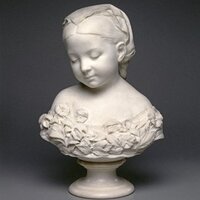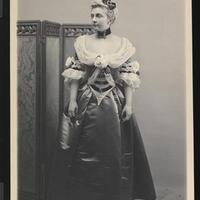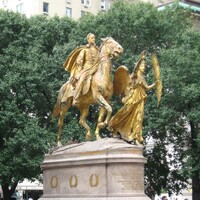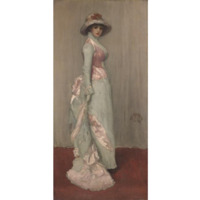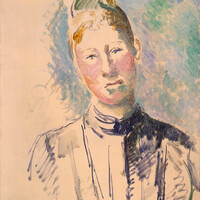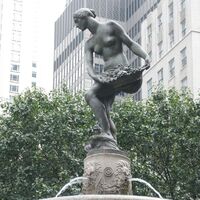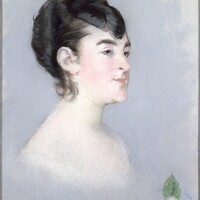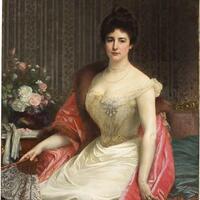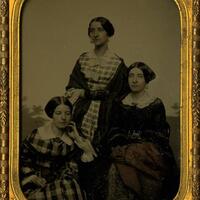Female Models of the Gilded Age
Of all the creatives of the Gilded Age, models featured in artwork across mediums remain largely unrecognized today. Here, the women whose likenesses were captured get their moment in the spotlight. The art featured in this section of the collection range from personal family portraits to public installations; all can be viewed in person, on a street corner or a museum archive.
Herma
Few resources share details of Herma's life. She was known as one of Gustav Klimt's favorite models. The artist described her as “having a backside more beautiful and more intelligent than the faces of many other models.” This painting was the second Klimt works to focus on a pregnant woman, and was initially entitled 'Vision' but has become known as 'Hope II' to follow the preceding painting that featured Herma, now known as 'Hope I.'
Annie Chickering
This marble sculpture of eight-year-old Annie Chickering (1859-unkown) was carved by the girl's uncle, artist Thomas Ball (1819 - 1911), in the late 1860s. In the sculpture, the young model appears contemplative, gazing down at the pansies and lilies covering her bodice. It also features a carved line from act 4 of Shakespeare’s Hamlet, in which Ophelia says to Laertes: “...and there is pansies, that’s for thoughts.” Some have speculated that the title of the piece is a pun combining the words “pansy” and pensée, which means “thought.” Little is known about Annie herself outside of descriptions of this sculpture.
Charlotte Augusta Warren
This photograph captures Charlotte Augusta Warren (née Tooker) in fancy dress at the James Hazen Hyde Ball, which took place on January 31, 1905. She was the oldest daughter of Gabriel Mead Tooker, a prominent New York lawyer and member of Caroline Astor's famous "Four Hundred," an exclusive list of high society Gilded Age families. Her husband, Whitney Warren (January 29, 1864 – January 24, 1943), was a successful Beaux-Arts architect who founded the architecture firm Warren and Wetmore in New York City, which is still considered to have been one of the most prolific in the United States.
Alice Claypoole Gwynn Vanderbilt
Alice Claypoole Vanderbilt (née Gwynne; November 11, 1845 – April 24, 1934) was the matriarch of the Vanderbilt family for over 60 years as the wife of 'the Commodore' Cornelius Vanderbilt. She had a passion for architecture, constructing several massive family houses; her enlargement of 1 West 57th Street made it the largest private residence ever built in an American city at the time. This dress was designed by the House of Worth for the Vanderbilt Costume Ball in 1883. Alice's “Electric Light” costume celebrated the new invention of the Industrial Age; her dress lit up thanks to Gilded Age batteries hidden in its folds. The lavish event was hosted at and in celebration of her sister-in-law Alva's newly built home, which covered an entire block of Fifth Avenue. The party cost an estimated $250,000 (approximately $6,000,000 in the 21st century). Newspapers reported the spending of $65,000 on champagne and $11,000 for flowers.
Hettie Anderson
Dedicated in 1903, this gilded-bronze equestrian group statue was master sculptor Augustus Saint-Gaudens’s (1848 – 1907) last major work and depicts one of the United States’ best-known generals, William Tecumseh Sherman (1820 – 1891). Leading Sherman in the statue is an allegorical figure of peace, modeled by Harriette Eugenia Anderson (1873 – January 10, 1938). Also known as "Hettie," she was a Black woman from Georgia, though listed as "White" in censuses and trained at the Art Students League of New York while working as as a clerk or seamstress. Saint-Gaudens described Anderson as “certainly the handsomest model I have ever seen of either sex” and "goddess-like." Nevertheless, he purportedly combined Hettie's facial features with those of his Swedish long-time muse and mistress, Davida Johnson, likely to appeal to the wealthy, predominantly white families living in the area. Anderson was considered one of the most popular art models of the time and posed for Saint-Gaudens on multiple occasions. In 1908, a year after his death, she copyrighted a bust he created of her in 1897 entitled 'First Sketch of Head of Victory Sherman Monument.' Her later refusal to give Saint-Gaudens' widow permission to make replicas of the bust led them to eliminate her identity and the bust out of official accounts of the sculptor's career altogether...aside from a a line from Homer about a model "supposed to have negro blood in her veins."
Susan Langdon Meux
Susan Langdon (also known as Valerie Susie Reece, 1852–1910) was painted by James McNeill Whistler around 1881. The daughter of a Devonshire butcher, she married Sir Henry Bruce Meux a 2nd Baronet, who came from one of Britain’s richest brewing dynasties. Meux’s Brewery was founded in 1764 and became a major brewer of porter ale in 19th-century London. Susan /Valerie is believed to have met him at the Casino de Venise in Holborn, where she worked as a banjo-playing barmaid under the name Val Langdon. Known for her unconventional behavior at high society functions, Susan/Valerie was often seen riding around the city of London in a carriage led by zebras and her home apparently featured an indoor roller skating rink. This is the second of three portraits Whistler made of her. 'Arrangement in Black and White,' her first portrait, is located in the Honolulu Academy of Arts. According to rumot, the third was destroyed by the artist before completion after an argument with his subject.
Mabel Hampton
Mabel Hampton (May 2, 1902 – October 26, 1989) was a lesbian activist, dancer during the Harlem Renaissance, and a volunteer for both Black and lesbian/gay organizations. While attending a women-only party in Harlem in 1919, Hampton was falsely imprisoned for sex work and sentenced time in the Bedford Hills Correctional Facility for Women; she was released after spending 13 months of a three-year sentence and viewed her imprisonment as being lesbian encoded.She provided significant contributions to the Lesbian Herstory Archives, a New York City-based archive, community center, and museum dedicated to preserving lesbian history; the Archives contain the world's largest collection of items created by and about lesbians. In 1976, Hampton donated memorabilia, ephemera, letters, scholarly publications, documentary records, and lesbian pulp fiction collected throughout her career to the Archives. The resulting collection opens a window into what life was like for Black lesbians in the time of the Harlem Renaissance.
Marie-Hortense Fiquet
Marie-Hortense Fiquet Cézanne, also known as Hortense Fiquet (22 April 1850 – 1922), was a French artists' model and wife to painter Paul Cézanne. She met her husband in 1869 at a Parisian art school called Académie Suisse. Académie Suisse was used by a number of prominent artists of the day as a place to meet each other and to paint the models who worked there. Fiquet's primary job was as a bookseller or bookbinder, but she combined this with part-time work as a model, which was how they met; Cézanne would paint her likeness in 27 oil portraits over the course of his painting practice. Despite this, they spent much of their married life living separately. Hortense may have provided inspiration for the character Christine in the Émile Zola novel, 'LŒuvre,' which appeared in serial form the year before the Cézannes' marriage. Zola was a friend from their schooldays, though the novel caused tension between them.
Doris Doscher
While Audrey Munson is attributed as the woman portrayed in the sculpture 'Pomona, Roman Goddess of Abundance,' located atop the Pulitzer Fountain outside the Plaza Hotel, it is actually the likeness of fellow model Doris Doscher. It was sculpted in 1915 by Karl Bitter. Doris Doscher (January 24, 1882 – March 9, 1970) was a model and silent film actress who later acted under the name Doris Doree and appeared in the movie 'The Birth of a Race' the same year the sculpture was revealed, playing the role of Eve. After ending her modeling career, she worked as a newspaper columnist, writing a daily column on health and beauty for the New York World. She lectured for years on similar topics.
Isabelle Lemonnier
Mademoiselle Isabelle Lemonnier (1857–1926) painted by Édouard Manet (1832–1883) in Paris, France. Isabelle Lemonnier was the daughter of Alexandre Gabriel Lemonnier, the Crown jeweller to Napoleon III. After meeting the painter in the 1870s, Manet created around 6 portraits of Isabelle between 1879 and 1882, including this one. She one of his favorite models in the later years of his life. As his health declined, Manet began hydrotherapy treatment in 1880 at a spa in Bellevue, near Paris. While in treatment, he wrote around twenty personal letters to Isabelle, often adding little watercolor drawings to the letters; one included a drawing of a plum and a short rhyme: "A Isabelle/Cette mirabelle/Et la plus belle/C'est Isabelle!" Another gently teased her for not replying to him while one that followed continued the flirtation; in closing the note, he wrote how he would send her a kiss "if he dared."
Misia Sert
Madame Thadée Natanson, also known as Misia Godebska or Misia Sert (1872-1950), painted in 1895 by Henri de Toulouse-Lautrec (24 November 1864 – 9 September 1901). Madame Natanson was known best as a patroness of the arts and poetry, supporting poets Paul Verlaine and Stéphane Mallarmé and artists including Toulouse-Lautrec, Pierre Bonnard, and Édouard Vuillard. She frequently hosted salons in her Paris apartments to share artwork with friends and nurture new artistic talent; in 1889, Natanson launched 'La Revue Blanche,' a French art and literary magazine. She later became a professional pianist and gave her first public concert in 1892. It was around this time when she married her 20-year-old cousin, Thadée (Tadeusz) Natanson. Three years later, this unofficial portrait was drawn for the cover of the 1895 final issue of 'L'Estampe Originale,' a quarterly periodical comprised of original artwork by young French artists. It shows stagehands bringing down the curtain on a performance with a plaster elephant placed atop a cartouche in the center. The socialite is seated at left of the frame. Now restored, this work was once sliced into two pieces and framed to show only Misia in her loge.
Virginia Michels Stern
Virginia Michels Stern or Mrs. Isaac Stern (1860-1927) painted by Jules Lefebvre (1830-1911) in 1898. She was the wife of the head of Stern Brothers, New York City's most opulent Gilded Age department store. This was the only information about her life found at time of completion of this project.
Elizabeth Harley, Matilda Anna Harley, & Hullina Harley
Like Stern's portrait, this photograph represents the embodiment of the purpose of this website: no information could be found about these women.
Charlotte Cushman
It is widely assumed that the angel depicted in the Bethesda Fountain statue was based on artist Emma Stebbins' longtime lover, American actress Charlotte Cushman. Cushman was known for her wide vocal range and could sing both male and female parts. Her retirement was announced at least seven times in as many different years; her final performance playing Lady Macbeth was at Booth's theatre in New York was at Booth's theatre. She took a similar farewell in the same character in Philadelphia and other cities and her career closed in Boston in 1875. After a reading tour to Rochester, Buffalo, and Syracuse, she retired with a large fortune to her villa at Newport, where she was seized with her final illness. Cushman was introduced to Stebbins in the late 1850s in Rome and the pair considered themselves married within the first year of their meeting; they went on to live together until Charlotte's death in 1876. Stebbins spent much of the rest of her life writing Cushman's biography, entitled 'Charlotte Cushman: Her Letters and Memories of Her Life.' Cushman was a descendant in the eighth generation from Pilgrim Robert Cushman, an organizer of the famous Mayflower voyage to the United States.

